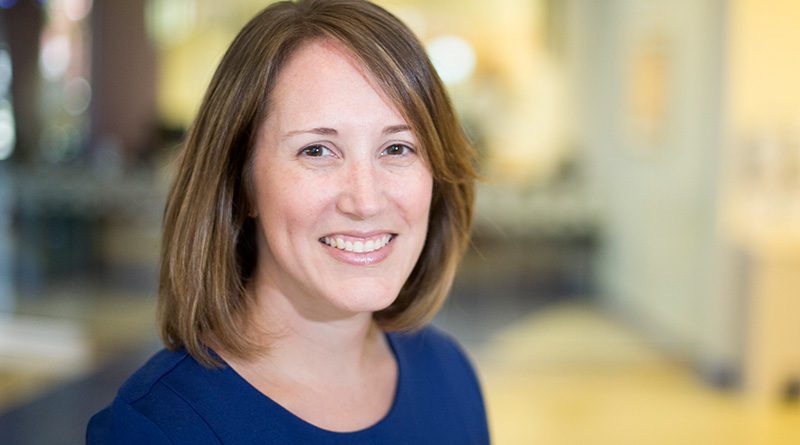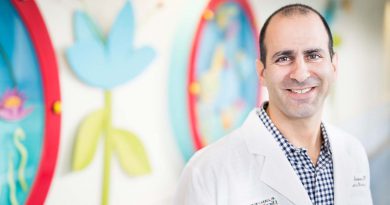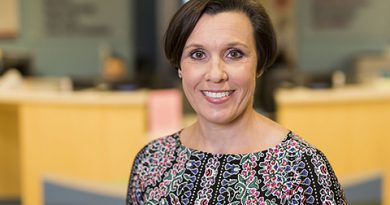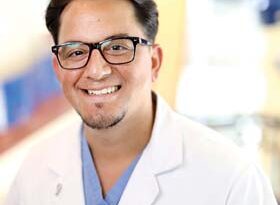Pioneers of Hope – Winter 2016
Published on January 26th, 2017 by user.
At Monroe Carell Jr. Children’s Hospital at Vanderbilt our work extends beyond patient exam rooms. We are also searching for discoveries to offer better treatments, and, hopefully, find cures for pediatric patients. The profiles here represent only a sampling of the tireless work performed daily to make Children’s Hospital a place of unwavering hope. In each issue, we also include a profile to highlight our longstanding partnership with our community pediatricians who help ensure all children receive the best care each and every day.
 Stephanie Spottswood, M.D., MSPH, professor of Radiology and Radiological Sciences and Pediatrics and chief of Pediatric Nuclear Medicine at Monroe Carell Jr. Children’s Hospital at Vanderbilt, doesn’t hesitate to come into work in the middle of the night, such as when a child experiences a medical emergency called an intussusception—where part of the small bowel gets stuck inside the large bowel, which can create a dangerous obstruction.
Stephanie Spottswood, M.D., MSPH, professor of Radiology and Radiological Sciences and Pediatrics and chief of Pediatric Nuclear Medicine at Monroe Carell Jr. Children’s Hospital at Vanderbilt, doesn’t hesitate to come into work in the middle of the night, such as when a child experiences a medical emergency called an intussusception—where part of the small bowel gets stuck inside the large bowel, which can create a dangerous obstruction.
Most of the time, pediatric radiologists can correct this with a fluoroscopic procedure. If not, surgery is required.
“When I’m successful, it often brings tears to the parents’ eyes,” Spottswood said. “It makes my day. It’s gratifying to be able to not just diagnose, but to also be able to treat and cure.”
Spottswood and other pediatric radiologists play an integral role in patient care at Children’s Hospital, and they are experts at selecting the best imaging techniques to diagnose medical problems. Examples of imaging procedures include X-ray, ultrasound, computed tomography (CT), magnetic resonance imaging (MRI), and nuclear medicine that uses radioactive material to diagnose and treat disease.
Pediatric radiologists also interpret test results to make diagnoses. For example, children with an injury such as a broken bone can be diagnosed with an X-ray. Congenital problems such as heart defects can be diagnosed at an early age using radiology. In addition, many childhood cancers are treated with targeted radiation to kill cancer cells and shrink tumors.
As a medical student at University of North Carolina-Chapel Hill, Spottswood had a hard time choosing a medical specialty until four patients with baffling symptoms came to the hospital while she was on duty. After seeing the power of radiology to accurately diagnose all of them, Spottswood was hooked.
She came to Vanderbilt University Medical Center where she became the first African-American to complete a radiology residency. She then completed a fellowship in pediatric radiology at Medical College of Virginia. She practiced radiology in Virginia for 12 years before joining Vanderbilt in 2005.
“You have to have an extra level of compassion to work with children,” said Spottswood. “I see that every day, with the faculty and staff here. Even when they’re exhausted, they still smile, are professional, and are committed to doing the best for our patients.”
Spottswood serves as chair of the Office of Inclusion and Health Equity (OIHE) Advisory Board at Children’s Hospital, a group charged with fostering a culture that promotes diversity and strives to meet the cultural needs of the patient population. Spottswood also mentors young women and underrepresented minorities, and in 2016, she was awarded Vanderbilt’s Margaret Cuninggim Women’s Center Mentoring Award. In addition, after recognizing that women in her department were not advancing as quickly as their male counterparts, Spottswood developed a faculty career development program for women.
“I come by this diversity passion honestly,” she said, pointing to a black and white photo above her desk of her grandfather Bishop Stephen Gill Spottswood with President John F. Kennedy. Spottswood was a leader in the African Methodist Episcopal Zion Church in Washington, D.C., and an 11-year chairman of the National Association for the Advancement of Colored People (NAACP).
“He was in the Kennedy White House talking about Civil Rights legislation and trying to move Civil Rights forward in the 1960s. He was pretty amazing,” she said.
Another little known fact about Stephanie Spottswood— she kicks up her heels in her hours away from Vanderbilt. She’s been dancing the Argentine tango for three years and is now the faculty adviser for the Vanderbilt Tango Club.
“I don’t think anyone knows that about me,” she laughed. “Well, they do now!”
– by Jill Clendening
If it takes a village to raise a child, Robert Lillard, M.D., knows from experience that it also takes a village to care for a child’s health. As a community physician with a close partnership with Monroe Carell Jr. Children’s Hospital at Vanderbilt, where he is also on staff, he has that village always at the ready to assist him.
“Our patients love it when they come to our office and say, ‘I was in the ER this weekend,’ and I say, ‘Well, let me pull up your visit right here.’ I log into StarPanel (the electronic medical records system used at Vanderbilt) and can see the record of their hospital ER visit. We’re independent, but we’re very connected, and our patients appreciate that.”
Lillard was born in Nashville and grew up in Memphis, Tennessee. He received a bachelor’s degree from Rhodes College and a medical degree from the University of Alabama School of Medicine. He completed his internship and residency in pediatrics at the Children’s Hospital of Alabama.
Lillard began private practice in Salt Lake City, Utah, before returning to Nashville in 1999. He joined The Children’s Clinic of Nashville, a private four-physician office, in 2004.
Two experiences during college convinced him to become a physician, Lillard said. He volunteered at Memphis Veterans Affairs Medical Center’s emergency room, where he had his first exposure working in the medical field. Then, he did an externship with chaplains at Methodist University Hospital in Memphis.
“You actually got to go into patients’ rooms, talk to them and get their stories,” he said. “It got you over that initial fear of ‘What’s on the other side of the door?’ That cemented it for me, and I thought, ‘I can do this!’”
When he went to medical school, Lillard thought he wanted to be an internist, but during the first week of his pediatric rotation, he found his true calling.
“It was doing all the same things, but your patients got better quicker, they rebounded, they gave you hugs, and you left happier,” he said.
As he began building his practice, Lillard realized he wanted to go beyond helping the patients who came through his door. By chance, a colleague asked if he’d like to run for a board position with the Cumberland Pediatric Foundation, a nonprofit organization that promotes pediatric health care through education, research and improved access. He has since spent eight years on the CPF board and is currently the group’s medical director.
“The experience with the Cumberland Pediatric Foundation has made me a much better advocate for children, and I’m able to talk to whomever it might be—employers, insurance companies or legislators. Early in your career, when you see things that aren’t right, you think, ‘How can I change that?’ As you get more involved, you realize you can coordinate efforts with others and be a more powerful voice in getting changes made.”
When Lillard’s not at the office, you might find him out on his daily run, watching University of Alabama football, or planning the next vacation with his wife, 17-year-old son and 12-year-old daughter.
– by Jill Clendening
 In high school Melissa Danko, M.D., excelled in science and math, and in dance—ballet, tap, jazz and pointe. Both took hard work, focus and discipline, traits that come in handy today in her life as a busy pediatric surgeon.
In high school Melissa Danko, M.D., excelled in science and math, and in dance—ballet, tap, jazz and pointe. Both took hard work, focus and discipline, traits that come in handy today in her life as a busy pediatric surgeon.
As a member of a semiprofessional dance company in Delaware, Danko would come home each day from high school, eat dinner, start her homework, go to dance classes for three to four hours a night, and then return home to finish her homework before bed. Friday was her one day off.
On Saturdays she practiced for over three hours in the morning and four at night, and on Sundays for seven hours straight.
Her high school principal told her he had no doubt she’d succeed in college and beyond because of her innate ability to organize and structure her life. He was right.
Danko, assistant professor of Pediatric Surgery at Monroe Carell Jr. Children’s Hospital at Vanderbilt, is a general surgeon, one who performs surgeries that aren’t included in other subspecialties—surgeries on the belly (hernias, tumors, appendectomies, feeding tube access), congenital defects, vascular malformations, lumps and bumps of the skin, and chest surgeries that do not involve the heart.
Her patients range from newborns who weigh 500 grams to those in early adulthood. Danko sees some patients with cerebral palsy or spina bifida well into their 30s.
Danko attended Duke University where she enrolled in the pre-med track and originally planned to become a physical therapist. During her junior year she enrolled in an independent study class through the Duke Marine Lab and she began to re-think her career path. Her project that year looked at the enzymatic properties of saliva in fiddler crabs, and she loved it.
“It was really fun. It was the first time I had done research, and I came back thinking I was going to be a marine biologist.”
Then, during her senior year, she took an immunology course, volunteered at Duke Children’s Hospital and decided to enroll in medical school. She took a year off between Duke and medical school to do research, and graduated from University of Pittsburgh School of Medicine in 2005.
After medical school she trained for seven years in general surgery (including two years of research) and served a two-year, sought-after fellowship in pediatric surgery with Dai Chung, M.D., Janie Robinson and John Moore Lee Professor of Pediatrics at Children’s Hospital. She joined the Vanderbilt faculty in 2014 because Children’s Hospital had many of the programs she was interested in, including oncology, congenital diaphragmatic hernia repair and ECMO (Extracorporeal Membrane Oxygenation, a procedure that uses a machine to take over the work of the lungs and sometimes the heart).
Danko chose surgery because of its immediacy of action. “Being able to do something to help someone now, instead of starting a medicine and seeing if it works, is very appealing to me. I also always loved building things and putting things together as a child.
But now she puts children back together again. One day she may remove a neuroblastoma tumor, which can be tediously wrapped around blood vessels, and another day she might have to internally rebuild an infant with a congenital malformation.
Danko points to a few photos of children above her desk.
“This little boy was here for six months. He had a perforated intestine. I couldn’t easily put him back together, and I took care of him for a long period of time,” she said. “He lived on feeding tubes and drainage tubes, and I finally got him past his course and got him well. It’s gotten to the point where I don’t need to see him anymore, and his family and I don’t know what to do. They send me pictures every couple of months. This one is from the Fourth of July,” she said, pointing to a photo of a smiling young boy.
Danko, who has recently started running and competing in half marathons, enjoys the outdoors, hiking and biking. She tries to stay active in her time away from work. She hasn’t danced since she helped choreograph a variety show in medical school. “Dancing was really fun. I miss it a lot.”
– by Nancy Humphrey
When Deborah Lowen, M.D., started her residency training in pediatrics at Children’s Hospital Colorado, she didn’t know about the specialty that would end up being her career calling.
“Most people don’t know about it,” she said of Child Abuse Pediatrics.
After an elective rotation in the specialty during her residency, Lowen began seeing the signs of abuse or neglect in patients, and her colleagues recognized her growing expertise. A couple of key events—working with patients who had clearly been abused or neglected and physicians who didn’t know how to handle those patients—made her path clear.
“In one case, I watched a well-meaning, but misguided physician essentially browbeat a child to try to get her to disclose what had happened,” Lowen remembered. “I was a lowly resident, but I made it clear that he needed to leave the room because I was going to protect this patient. I talked to her very gently and told her we were going to take good care of her.”
The patient talked about the abuse the next day, Lowen said.
Lowen, associate professor of Pediatrics, went on to complete a fellowship in Child Abuse and Neglect at Brown University School of Medicine. She has practiced as a child abuse pediatrician for 19 years, with nearly six of those as the director of the Center for Child Protection and Well-being (CARE Team) at Monroe Carell Jr. Children’s Hospital at Vanderbilt. The team includes child abuse pediatricians, nurse practitioners and pediatric social workers.
The CARE Team provides medical evaluations when there are concerns about possible abuse or neglect. Lowen also serves as a liaison with law enforcement and child welfare organizations, and she is often called on to provide expert testimony in the court system.
“We try to determine if an injury was from an accident, or if there is a medical problem that is mimicking abuse,” Lowen said. “Sometimes I have to say that I don’t know whether it is abuse, and I’m not afraid to do that.”
Lowen tires of the “constant accusations that we (child abuse pediatricians) are biased and lying and want to have kids taken away,” she said.
She will continue to go to court and testify though, even in cases where a child has died and there are no other children in the family to protect.
“My going to court in that kind of case doesn’t help that child, but there is a role for being a truth-teller,” she said. “I think society needs to hear that this stuff happens, and that it doesn’t just happen in families that look different than yours. It happens in all walks of life and in your community. Too many kids get abused over and over because too many people turn a blind eye.”
When Lowen is not busy seeing patients, testifying or educating others about how to recognize abuse and neglect, she enjoys being with her husband, a high school mathematics teacher, and her 19-year-old son and 8-year-old daughter.
She loves being outdoors, hiking and gardening, and she loves to read.
“But I don’t read anything about child abuse or children getting removed or anything like that,” she said.
– by Leigh MacMillan




